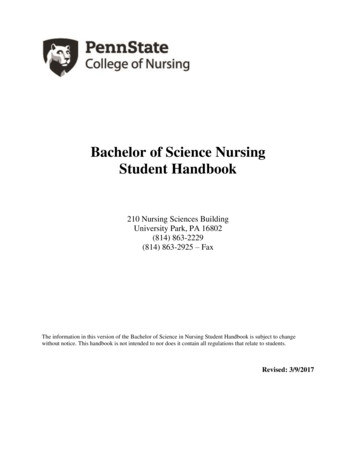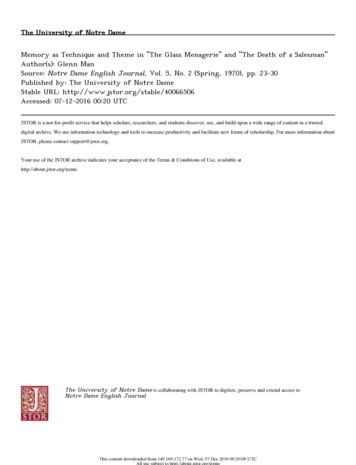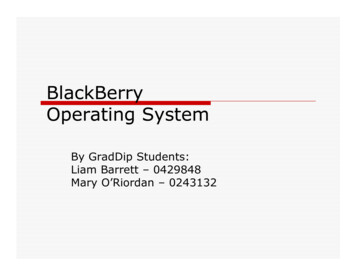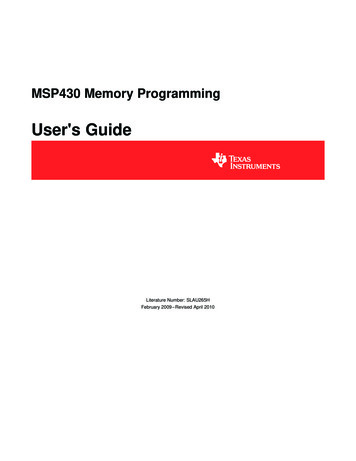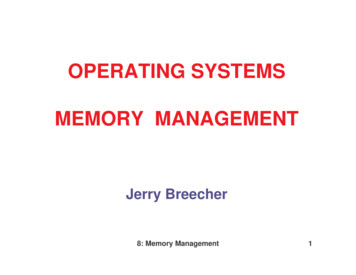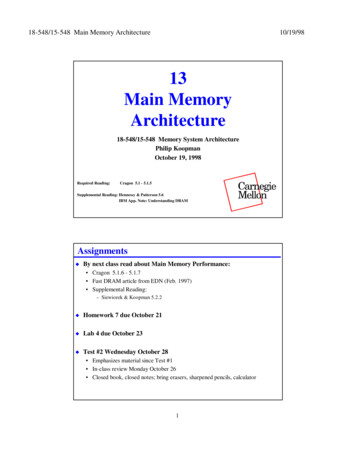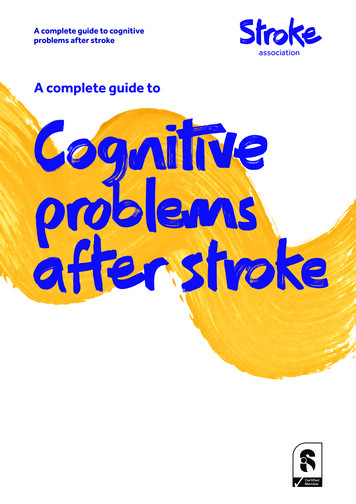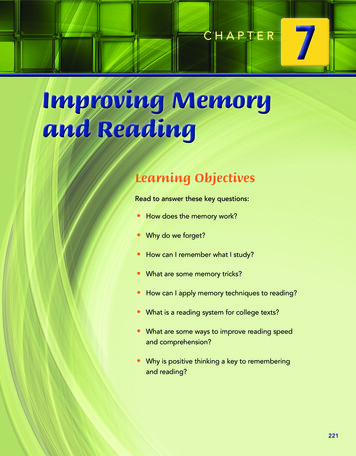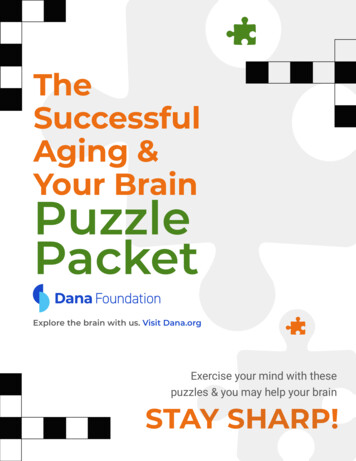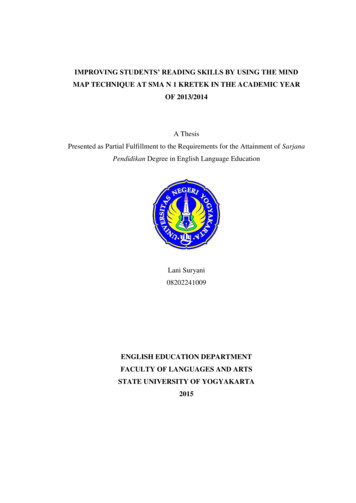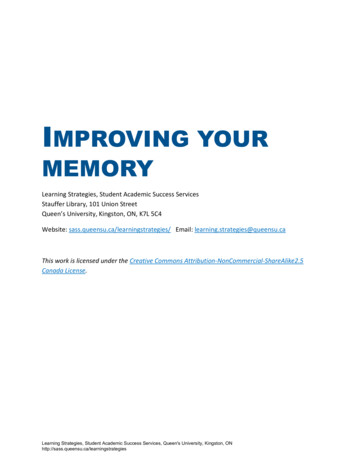
Transcription
IMPROVING YOURMEMORYLearning Strategies, Student Academic Success ServicesStauffer Library, 101 Union StreetQueen’s University, Kingston, ON, K7L 5C4Website: sass.queensu.ca/learningstrategies/ Email: learning.strategies@queensu.caThis work is licensed under the Creative Commons Attribution-NonCommercial-ShareAlike2.5Canada License.Learning Strategies, Student Academic Success Services, Queen's University, Kingston, ONhttp://sass.queensu.ca/learningstrategies
Memory at universitySelf-reflection questions What role does a good memory have in your academic life?Do you know how your memory works?Memorization is one of the most common types of learning used in university. Due to the largevolume of information which needs to be learned, having strong memory skills and usingeffective memory strategies is critical for success at university.Memorizing comes into play at all stages of a degree but is most crucial at the outset of aprogram as each discipline has its own body of core knowledge. Often students complain thatthey have ‘so much to memorize’; however, if the core knowledge is not committed to memoryearly in a program, the student will struggle to acquire more difficult and complex information.Moreover, some courses require you to memorize specific facts or rules, e.g., language courses.Science course (biology, anatomy) also require a large amount of information, alongsideunderstanding concepts.To remember all that‘s required to successfully complete a course, information needs to bereviewed frequently. For students who cram the course material at the end of the term will findthat much of the information is lost soon after the final exam, and they will have to relearn itnext term. What a waste of time!Purpose of this moduleThe aim of this module is to provide information about how your memory works and offeruseful strategies to assist in the process of remembering. Although strategies involvingrepetition are most commonly used to assist memory, this module goes beyond simple rotememorization to whole brain techniques which will help you unleash your powerful memory.ThemesI. How Your Memory WorksII.Whole Brain LearningIII.Forgetting & RememberingIV. Memory Training: Basic & Advanced StrategiesV. Negative Effects on Memory: substances, sleep, nutrition, etc.For those interested in a more detailed explanation, we have prepared additional informationsheets and hands-on tools. You can find them in the Tools section at the end of the module.Learning Strategies, Student Academic Success Services, Queen's University, Kingston, ONhttp://sass.queensu.ca/learningstrategies
Self-assessment of memory functioningSelf-reflection questions Would you say you have ‘a good memory’?Are you aware of the memory skills and strategies you use?Are you aware of the memory strategies which are the most effective in helping youretain and recall information?Do you want to improve your memory?How good your memory is can be determined both objectively and subjectively. Dr. Gary Small,a memory expert at University of California Los Angeles, has developed two assessment tools*,an objective test and a subjective questionnaire, which will help you assess your presentmemory functioning. See: Subjective Memory QuestionnaireObjective Memory Test*Source: Small, G. 2003. The Memory Bible: An innovative strategy for keeping your brainyoung. NY: Hyperion.Interpreting your memory scoresOnce you have completed Dr. Small‘s memory tests, take a moment to find out how your scorestranslate into a memory skills training ogramReview basic memory skillsand then move quickly toadvanced skills.Focus on basic memory skillstraining. Reassess yourscores after the basictraining is complete. Ifthere’s no improvement,consult an expert.Focus on stress reductionbefore basic memory skillstraining.Factors influencing objective memory score: ageLearning Strategies, Student Academic Success Services, Queen's University, Kingston, ONhttp://sass.queensu.ca/learningstrategies
level of education (those with higher levels of education generally have bettermemories)Factors influencing subjective memory score: mood and sense of well-being (stress and depression affects memory)Continuous assessment of memory improvementBy taking the above tests, you now know your baseline memory performance scores. You willwant to revisit these scores throughout your memory training program to assess your ongoingimprovement. On the continuums below, mark your baseline score with an X.Baseline: Subjective0459013518022590135180225Baseline: Objective045Learning Strategies, Student Academic Success Services, Queen's University, Kingston, ONhttp://sass.queensu.ca/learningstrategies
I. How your mind worksModel 1: 3 phasesWhen you understand how your memory works, reviewing new information regularly makes awhole lot of sense. Memory is an active process involving thinking about the information,encoding the information and rehearsing the information. This happens in 3 phases.Phase 1. AcquisitionWorking memory or the immediate sensory image (e.g. a picture). This phase fades in secondsunless you pay attention to certain features or transform (encode) the information into words.Phase 2. StorageShort-term memory or the temporary storage. This phase is small in capacity (3-10 items) andshort in duration (10-30 seconds) unless information is repeated verbally.Long-term memory. This phase is the relatively permanent, large capacity storage which holdsour past. ‘Memorized’ information is stored here, and this phase is what most people think ofas their ‘memory’.Phase 3. RetrievalThis phase involves getting information out of your long-term storage and using it.Adapted from: Fleet, J. et al. (1990). Learning for Success: Skills and Strategies for CanadianStudents. Toronto, ON: Harcourt Brace Janovich.Model 2: 5 stages of information processingWhy is it that sometimes when you are trying to solve a problem, you simply can‘t and then inthe middle of the night you remember? The knowledge is accessible now because you are nolonger ‘thinking’ and have moved to unconscious levels of thought. Since the unconscious mindLearning Strategies, Student Academic Success Services, Queen's University, Kingston, ONhttp://sass.queensu.ca/learningstrategies
is more powerful than the conscious, it‘s important to understand how to tap into these levelsof thought. To help you understand this process, consider these 5 stages or levels:Conscious1. Think stage Bridge to Unconscious2. Emote stage Unconscious3. Look/search stage(retrieve)4. Create stage5. Know stage1. Think – what you do consciously, e.g., analyze, compare, ask yourself questions. Informationis not accessible till the Know stage.2. Emote – To get to the Know stage more quickly, use your emotions. Your emotions are abridge between your conscious (Stage 1) and unconscious mind (Stages 3-5). Emotions are your‘gut’ feelings and are a deeper stage of your mind than Stage 1. Once your emotions areinvolved, you will automatically move to the Look/Search stage.3. Look/Search – Signalled by your emotions, your mind searches for information stored in yourmemory. Try using the analogy of a filing cabinet (see diagram in the TOOL below) to representeverything you have seen, heard, thought is stored in files. When your mind is in Look/Searchmode, imagine your unconscious mind ‘rolodexing’ or ‘scrolling’ rapidly all your files. Note thatyour mind doesn‘t always need to go through Stage 3, but can go directly to Stage 5.4. Create– In the case of problem-solving, your moves through the Create stage before theKnow stage, as the necessary ‘files’ don‘t yet exist. To create a new file, your mind goes throughthe existing files, taking bits of useful information and recombining files into something new.Usually this takes time and conscious effort. However, often when you stop ‘thinking’ about theproblem and let the unconscious take over, the solution appears, seemingly effortlessly. Whenyou are creating new files, you are creating new neuro-pathways in the brain, which reinforcesyour memory. When you create something, you ‘know’ it, i.e. you‘ve arrived at Stage 5!Therefore THE MORE YOU CREATE, THE BETTER YOUR MEMORY GETS. So, when studying andlearning try to create your own questions, and visuals and your memory will improve easily.Source: Trudeau, K. 1997. Mega Memory: How to release your superpower memory in 30minutes or less a day. NY: HarperCollins.See The Filing Cabinet of Your Mind for more detail.Learning Strategies, Student Academic Success Services, Queen's University, Kingston, ONhttp://sass.queensu.ca/learningstrategies
II. Whole brain learningBrain research and memoryTraditionally, researchers thought thinking processes were divided between the two sides ofthe cerebral cortex like this Right hemisphereLeft hemisphereRhythm, imagination, daydreaming, colourLogic, words, lists, numbers, sequence,dimension, spatial awareness, gestalt (thelinearity, analysiswhole picture)However, the latest research indicates that we use both sides of brain together. Therefore, themore you use them together, the more they benefit each other. For example, the study ofmusic (right hemisphere) helps the study of math (left hemisphere) the study of mathhelps the study of music. The more you use these areas, the more generally capable is yourentire memory. Therefore to remember well, you need to use every aspect of your mind.Two fundamentals of super memory: imagination associationIf you want to remember anything, associate (link) it with some known or fixed item (i.e.something stable in your mental environment), calling upon your imagination throughout. Toremember well you need to include some or all of the following:Senses: see, hear, smell, taste, touch, movementMovement & Rhythm – make your images ymbols e.g. a light bulb an ideaColour – add vivid coloursOrder and/or Sequence e.g. little to big, sorting by category, colour groupings, hierarchiesPositive Images - pleasant images are easy to remember while negative ones can block memoryExaggeration – size, shape, soundThe acronym to help you remember the list above is SMASHIN’ SCOPE.Source: Buzan, T. (1995). Use Your Memory. London: BBC Books.Learning Strategies, Student Academic Success Services, Queen's University, Kingston, ONhttp://sass.queensu.ca/learningstrategies
III. Forgetting and rememberingWhy we forgetDid you know that about 60% of the material that you read is lost in the first hour afterreading?The primary reason we forget is Interference or ‘The Confusion Factor,’‖eg. mentalovercrowding, multi-tasking. The more similar the event or fact that intervenes, the more likelyyou will forget.Other reasons we forget are Negative attitude or self-concept e.g. “I have a lousy memory”Underlearning: not learned well enough and is easily forgottenDisuse: materials is most rapidly lost after initial learning (see statistic above)Changed cues: the right cue is missing e.g. you studied one way but the test question ispresented in another wayLack of attention/ effort/ concentrationSee Reasons for Forgetting.How we rememberWe remember by Thinking Encoding Rehearsing Retrieving. We remember in pictures.Memory is helped by: Organization and orderFunnel approach: moving from general to specificAssociations/ connections with prior knowledgePersonal meaning - emotionsGrouping or chunkingLong-term memory is helped by Repeating and recitingRehearsing : reciting or repeating but in the actual place you need to remember theinformationElaborating (deep processing) ConnectingTeaching someoneSee Forgetting: Solutions.Learning Strategies, Student Academic Success Services, Queen's University, Kingston, ONhttp://sass.queensu.ca/learningstrategies
IV. Memory training: Basic memory strategiesLearn and use strategies!Clair Beaulne, a memory consultant based in Chelsea, Quebec, say that people with goodmemories use memory strategies. The following strategies are grouped by: associating andlinking strategies, whole brain strategies, organizational strategies, and rehearsal strategies.Source: Tactics to improve a sluggish memory: New activities, rhyming techniques, eat well.Canadian Press. Written by: Lisa Abel August 20, 2007.1. Association & linking strategiesGULP!G- Get it! Experience the initial learning with as many senses as possible.U- Use it! Write it, repeat it, sing it.L- Link it! Link it to what you know: something with personal meaning, to a location, a sound, anacronym.P- Picture it! Create a visual image of the association you made. Make it bizarre, colourful, vivid.Look, Snap, ConnectLook: Actively ―observe‖ what you want to learn. Use all five senses.Snap: Visualize/Create mental snapshots of memories.Connect: Link your mental snapshots together to help your recall.See Look, Snap, Connect for more.To remember names:Look: make sure you really listen to and observe the person‘s name.Snap a visual image of the name and the face.Connect the name-snap with the face-snap.Chaining a story or narrativeWhen you need to remember a long list of random, unassociated items, try linking themtogether in a bizarre, vivid, nonsensical ACTION-based story. By doing this, you will probablynever forget a link in the chain! Sample story using the words from Dr. Small‘s objectivememory test: plank, banker, sauce, umbrella, reptile, abdomen, lobster, orchestra“On a long gangplank teeters a banker. In one hand he holds on umbrella and in theother, a jar of tomato sauce which he furiously douses on a large reptile crawling on itsabdomen below him. The reptile is devouring a lobster as it makes its way up theLearning Strategies, Student Academic Success Services, Queen's University, Kingston, ONhttp://sass.queensu.ca/learningstrategies
gangplank towards the banker. In the background an orchestra plays eerie sounds ofpending doom.”Pegging or lociPegging takes new information and pegs (connect/ link) it to information that cannot beforgotten. Pegs are like the tabs on a file folder; they allow you to retrieve new things at aglance. You might also visualize a peg as a hook on a wall or in a closet, where you hang ajacket. This makes recalling new information easier because we have pegged it to something wealready know.What can I use pegs for? LOTS of things ‘To Do’ listsList of unrelated wordsA sequence of eventsA sequence of numbersAddressesDirectionsNames and facesSee Pegging & Creating Peg Lists and Pegging for Remembering Numerical Sequences &Equations.AcronymsHow? Use the first letter of a list to form a word, sentence, or phraseWhy? To remember lists of people, places or things; sequences, steps, formulaeE.G. HOMES Great Lakes i.e. Huron, Ontario, Michigan, Erie, SuperiorAcousticsHow? Link new learning with substitute words that sound alikeWhy? To remember vocabulary, foreign languages, names, dates, matching item (for a test)E.G stalactite & stalagmite: A stalactite holds "tite" to the ceiling of a cave.Songs & rhymesRemember how difficult it was to learn your ‘times tables’? Today some primary schoolteachers are using rap music to help kids remember 2x2. Not only does using music and rhymeshelp kids learn faster, it’s fun, too.Learning Strategies, Student Academic Success Services, Queen's University, Kingston, ONhttp://sass.queensu.ca/learningstrategies
How? Create a rhyme, song, or poem to associate new material. Why? To remember rules,theoremsE.G. A rule: “I”‖ before “e” except after “c” with a rap beat!E.G. A list: “30 days has September, April, June, and November.”Olfactory memory aidsAfter smelling rosemary oil, students in the UK showed improved marks on a memory test.Consider associating a favourite smell with something you are trying to learn and remember.2. Whole brain strategiesMind mappingMaking a mind map is a whole brain activity, i.e., it engages both left and right hemispheres ofthe brain. Mind maps are both verbal (words) and non-verbal (pictures, symbols, colours).Visual patterns provide a framework for recall.For information on creating and using mind maps, see our online resource on Note-taking andReading.“Memory” musicAt University of Wisconsin, Drs. Francis Raucher and Gordon Shaw and their team ofneuroscientists showed university students who listened to Mozart piano sonatas improvedtheir spatial cognitive abilities e.g. following patterns. Other studies have shown that universitystudents perform better on tests with background classical music instead of silence.Even if you are skeptical of these outcomes, we know that music can enhance immunefunctioning, diminish pain, and elevate mood. And a better mood can sharpen mental ability.* Source: Small, G. 2003. The Memory Bible: An innovative strategy for keeping your brainyoung. NY: Hyperion.See Super Memory & Music.3. Organizational strategiesLearn from General to SpecificDon‘t go for the details first; there‘s more chance that you will get lost. When reading, forexample, firstly skim the text to get the gist. If you get the big picture, it is easier to rememberthe detail because you see how the detail connects to the whole.Learning Strategies, Student Academic Success Services, Queen's University, Kingston, ONhttp://sass.queensu.ca/learningstrategies
Distributed practiceStudy in short sessions over a long period versus cramming for concentrated periods of time.Cramming is an ineffective way to help you remember as, you have learned, memory is addedby rehearsal (e.g. reviewing, elaborating) which takes time.See The Distribution of Practice Effect.Ordering/ChunkingDecide on an order of importance and organize the material into an outline or framework.When reading, keep in mind the larger pattern of the book or journal article as you progress soyou can relate subordinate ideas (e.g. details) to the larger pattern. Mind maps are a great toolfor visualizing large patterns from subordinate ideas.SelectionConcentrate on the most significant information. The type of memory strategies you use mightdepend on the nature of the course. That is, some courses require you to focus on the bigpicture (e.g. themes, concepts, patterns) while others require attention and memorization ofdetail.4. RehearsalRecitingRemember that 60% of what you read is lost after the 1st hour unless you review the material.Both verbal and written recitation of the material will stave off rapid forgetting.You may recitewhile you read through each paragraph or section. Recite in you own words. Rephrasing orparaphrasing shows that you really know the information.Source: Utah State University’s Academic Resource Centre.Reviewing & self-testingSee our online resource Exam Prep for ideas on reviewing and self- testing.OverlearningYou can ‘say it in your sleep’! Overlearning is especially important when preparing for tests andexams because it will protect you if test anxiety blocks your ability to recall what you’ve mostrecently learned.Learning Strategies, Student Academic Success Services, Queen's University, Kingston, ONhttp://sass.queensu.ca/learningstrategies
TeachingWhen reviewing for an exam, talk to someone (e.g. use a study group), or yourself, about thetopic you've been studying. When you are able to explain the information clearly andintelligently, you have really learned it.Sleep on it!We do a lot of thinking while we sleep—sometimes our most creative thoughts occur duringthe subconscious sleep state. Freshly learned material is better remembered after sleep thanafter an equal period of daytime activity when interference may take place. While we sleep ourminds are busy sorting, filing, and deleting information.Advanced memory strategiesRemembering new or long wordse.g. AcetaminophenAcet a seatamino a minnowphen finI’m on a seat in my boat fishing with a minnow when a fin surfaces the water and steals mybait!e.g. Spanish verb ‘to bring’ traer. Think of a waiter bringing a ‘tray’ of food to your table.Remembering written passagesTo learn verbatim text:Break material into small chunks (sentence, phrase, concept, word). Read the text out loud,paying attention to the key word in each chunk. Convert the beginning of each chunk intopictures, using nonsensical action. Now either chain into a story or peg them to one of your peglists.Run through the pictures in your mind while repeating the passage verbatim and aloud.For large sections, personalize it by putting yourself in the picture then pick all the keywords/phrases and turn them into pictures. Again, chain them into an exaggerated story. Tocommit to memory, run through the pictures in your mind and repeat the passage verbatimaloud.See Remembering Written Passages.Learning Strategies, Student Academic Success Services, Queen's University, Kingston, ONhttp://sass.queensu.ca/learningstrategies
Remembering difficult namesFor names that do not invoke an image, you need to use more advanced memory techniques.Break the name into syllables and associate each syllable with a word (preferably a noun). Thenchain the word-substitutes together to create a visual image.E.G. You want to remember the last name of the guy who invented this technique: KevinTrudeau. Start by breaking his surname into 2 syllables: Tru and Deau. Now associate thesyllables with substitute nouns which are easy to remember. e.g. 1st syllable sounds like ‘true’.Second syllable sounds like a doe or a female deer. So we have: True doe.Now chain the substitutes together:I’m at the archery range shooting at a cardboard cut-out of a deer while a TRUE DOE laughs atme from behind a nearby tree!Repeat & associateRepeat the person‘s name during the initial conversation. If possible, comment on how thatperson reminds you of someone else you know with the same name.See it & write itIf the person has an unusual name, ask him/her to spell it out and then visualize an image ofthe name spelled out.The Major Memory System‘The Major Memory’ system is one of the most powerful memory systems available. It takes awhile to master, but once learned is very powerful. It works by:1. linking numbers to consonants2. converting the consonants into words (ideally nouns which create vivid images)3. sequencing these images together into a storyline.These sequences can be very complex and detailed and a large amount of information can beaccurately memorized. Advanced memory is focused on numbers because numbers give moreopportunities to apply memory techniques. To take advantage to this, you should have‘numbered pictures’ committed to memory. These numbered pictures serve as your advancedmemory vocabulary.(For a list of 100 “numbered pictures” see Kevin Trudeau’s Mega Memory book).See Major Memory System – Remembering Very Long Numbers.Learning Strategies, Student Academic Success Services, Queen's University, Kingston, ONhttp://sass.queensu.ca/learningstrategies
The strategies below have been adapted from Kevin Trudeau‘s book Mega Memory.Remembering chemical elementsE.G. Xenon. Atomic number is 54. Atomic weight is 131.291. Xenona. Break info into small chunks. XEN ON.b. Turn into pictures. XEN zen out as in chill out ON (same)2. Element No. 54a. Use your Picture Words. If you don‘t have a picture word for 54, make one up.b. E.G. 5 4 la ra lure3. Atomic Weight: 131.29a. Use your Picture Words or make up one.131 ta, ma, ta, tomato. 29 na, pa, nap4. Put it all together a. I’m trying to zen out on (Xenon) my hammock, but my friend tries to lure (54)me out to play. I pick up a tomato to hurl at her. She runs away and I go back tomy nap (131.29).Remembering dates and namesE.G. 1st PM of Canada was John MacDonald, first appointed in 1867.1. Convert numbers to consonants and then to images.a. 1st: ta, toeb. John A. MacDonald: john is slang for toilet and MacDonald reminds me of aBigMac.c. 1867: 18 ta, va, TV 67 cha, ca, cheekd. Noun/Images: Toe, John, BigMac, TV, cheek2. Chain a story: I stub my toe and on the way to the john to get a bandage, I see that mysister has left her BigMac on top of the TV. Forgetting my bloody toe, I grab her foodand stuff into my cheek as I hear her footsteps approaching Learning Strategies, Student Academic Success Services, Queen's University, Kingston, ONhttp://sass.queensu.ca/learningstrategies
V. Negative effects on memoryLack of sleepSleep plays a vital role in organizing and laying down memories. So, it‘s not too surprising that arecent U.S. survey1 discovered that students who study all night have slightly lower grades thanthose who sleep. Good sleep hygiene is critical to good memory so aim for a full night‘s sleep,especially when studying for tests and exams.For more information about sleep, see our online resource on Exam Prep or Prevention.com’sarticle “Snooze it or Lose it.”Drugs & alcoholSmoking marijuana causes short-term memory deficits which can persist for some weeks afterstopping. So, if you use these drugs, think twice about smoking in the weeks before exams.See Marijuana & Memory.Having a hangover is more than a nuisance when you need to think hard while studying, takingnotes in a lecture, writing an essay, etc. Alcohol impairs judgment, slows your reaction time,and affects your sleep patterns. Alcohol is also a depressant which can negatively affect yourmood.See Alcohol & AcademicsFood & nutritionGood nutrition is important for thinking and for memory. Toronto scientist, Dr. CarolGreenwood, conducts research on how general health and diet contribute to brain function anddecline.2 In her research, people who ate complex carbohydrates for breakfast (whole graincereals and breads) got a memory boosting impact of the carbohydrate. But those who ate asimple carbohydrate, like white bread, experienced memory decline after that.Food & drinks that help memory: Omega-3 fatty acids (e.g. oily fish like salmon, walnuts), andfruits and vegetables, particularly brightly coloured ones which are high in anti-oxidants.Another ‘brain food’ is lecithin, a phospholipid containing ‘choline’, a building block of one ofthe neurotransmitters in the brain that form thought and memory. Foods rich in lecithin are1Source: Toronto Star, “Night School a Failure.” December 20, 2007. The study was conducted by Dr. PamelaThacher and published in the January issue of Behavioral Sleep Medicine.2Source: Tactics to improve a sluggish memory: New Activities, rhyming techniques, eat well. Canadian PressWritten by: LISA ABEL Aug. 20, 2007Learning Strategies, Student Academic Success Services, Queen's University, Kingston, ONhttp://sass.queensu.ca/learningstrategies
soybeans, eggs, and wheat germ. You can also buy lecithin as a supplement in the healthsection of most grocery stores. Drink lots of fresh water, too.Foods & drinks that hinder memory: refined sugars and white flour, food with MSG andaspartame (e.g. Nutrasweet), coffee (can provide a short term memory boost, but it can makeyou jittery).Anxiety/stressWorries about your academic and/or personal life can affect your ability to concentrate and,therefore, remember what you‘ve heard, read, or observed. Stress causes your mental wheelsto spin around preventing you from releasing the unconscious thought processes that get youto the highest level of information processing (i.e. Know Stage). The good news is that you canlearn to manage your stress with the right mindset and useful coping strategies. Kevin Trudeau,in his bestseller Mega Memory, outlines an interesting eye movement technique that canreduce stress and help recall. It‘s easy and you can do it anywhere. Try it during your next test!If you suffer from high levels of stress, consider consulting a learning strategies or personalcounsellor at Queen‘s Counselling Services.See Using Eye Movements to Reduce Stress and Help Recall.Illnesses & medicationsSome medications can negatively impact concentration and, in turn, your ability to recall. If youneed to start of new course of meds which might impair your memory, especially at very busytimes during the term (e.g. midterms/exams), consider making your professors aware of yoursituation. If you’re not comfortable doing this, consult a learning strategies or personalcounsellor at Queen‘s Counselling Services. Some meds, for example those for Attention DeficitHyperactivity Disorder, indirectly help your memory by assisting with concentration and focus.AgingFor the mature aged student reading this module, you might be wondering if your age hasanything to do with ability to retain and recall information. The good news is that aging is not asbig a factor in memory loss as was once thought. Recent studies have shown that we can retainour memories if we continue to ‘exercise’ them, i.e. practice daily activities to aid memory suchas word games or learning a foreign language.Learning Strategies, Student Academic Success Services, Queen's University, Kingston, ONhttp://sass.queensu.ca/learningstrategies
TOOLS FORIMPROVING YOURMEMORYLearning Strategies, Student Academic Success ServicesStauffer Library, 101 Union StreetQueen’s University, Kingston, ON, K7L 5C4Website: sass.queensu.ca/learningstrategies/ Email: learning.strategies@queensu.caThis work is licensed under the Creative Commons Attribution-NonCommercial-ShareAlike2.5Canada License.Learning Strategies, Student Academic Success Services, Queen's University, Kingston, ONhttp://sass.queensu.ca/learningstrategies
Subjective Memory QuestionnaireOverall memoryHow would you rate your memoryoverall?Poor1Good234Excellent567How often do these present aproblem for re I put things (e.g. keys)Performing household choresDirections to places111222333444555666777Phone numbers I have just checkedPhone numbers I use frequently11223344556677Things people tell meKeeping up correspondence11223344556677Personal dates (e.g. birthdays)1234567WordsForgetting what I wanted to buy at thestor
mood and sense of well-being (stress and depression affects memory) Continuous assessment of memory improvement . By taking the above tests, you now know your baseline memory performance scores. You will want to revisit these scores throughout your me
